Nemacheilus elegantissimus Chin & Samat, 1992
Synonyms:
Nemacheilus elegantissimus Chin & Samat, 1992
original designation
Vernacular names:
English
Elegant Loach
Etymology:
The generic name ‘Nemacheilus’ is composed of two greek words; ‘néma’ means ‘thread’, ‘cheilos’ means ‘lip’; the composition is an allusion to the filamentous barbels around the mouth.
The specific epithet ‘elegantissimus’ is the superlative of elegant meaning ‘the most elegant’; an adjective which has to agree in gender with the generic name.
Size / Weight:
max. 53 mm SL, male, unsexed (Chin & Samat, 1992).
Roughly 43 mm TL (ME, pers. obs., 2009-06-04, EW-MAL 10-09).
Figure 1. Nemacheilus elegantissimus; not preserved; 43 mm TL; lateral view; EW-MAL 10-09, Sungai Telupit, Sabah, Borneo, Malaysia.
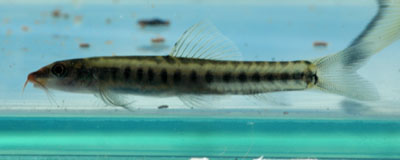
Diagnosis:
Coloration: 17-21 blotches along lateral line; lateral line somewhat light green iridescent; shares synapomorphies of N. longipectoralis group (see remarks).
Sex differentiation:
Unknown for N. elegantissimus; closely related species show sexual dimorphism; suborbital flap, first branched pectoral ray thicker and tubercles on dorsal surface of pectoral rays and body above in males.
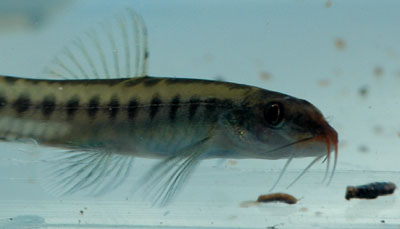
Distribution:
Inhabiting riverine environments with slow to fast current running over flat round pebbles; clear and transparent water; pH 7.6; 29 ºC (measured in 30 cm depth); 80 µS/cm (ME, pers. obs., 2009-06-04, EW-MAL 10-09).
Populates Sungai Segama (terra typica) in the Danum Valley Conservation Area, National Park, Tawau Division, Sabah, Borneo, Malaysia, and the upper reaches of the Sungai Kuamut, a tributary to the Sungai Kinabatangan, Sandakan Division, Sabah, Borneo, Malaysia (Chin & Samat, 1992; Martin-Smith & Tan, 1998). Also occurs in the Sungai Telupit, a tributary to the Sungai Labuk, Sabah, Borneo, Malaysia, which seem to mark the northern boundary of distribution (ME, pers. obs., 2009-06-04, EW-MAL 10-09).
Endemic to basins east of Crocker Mountain Range, Sabah, Borneo, Malaysia.
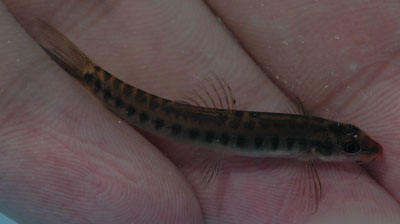
Ecology:
Benthopelagic; grouping in 4-6 individuals; never singly; permanently, agilely foraging above substratum; around 10 m in front of riffle section at 50 cm depth, always keeping slightdistance to substratum, permanently browsing; syntop with Rasbora sumatrana (Bleeker, 1852) and Gastromyzon spp. in EW-MAL 10-09, Sungai Telupit, Sabah, Borneo, Malaysia; stream with slow current, canopy coverage 30%, max 30 m, 1.2 m deep, riffle section 0.3 deep, no vascular water plants, bottom: sand, pebbles, boulders, leaf litter, wood; water: clear; 98 m asl (ME, pers. obs., 2009-06-04, EW-MAL 10-09).
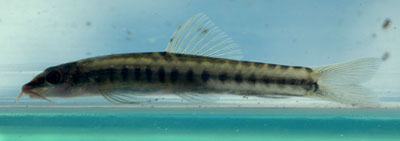
Conservation status:
IUCN Red List not evaluated.
Aquarium maintenance:
As in the natural biotope a group of fishes should contain at least 4 individuals; 80 cm tank due to extensive movement of the group; flat round pebbles, slow water movement; voluminous filtration; driftwood, plants in the back creating space for hiding; requires much open space for swimming.
Not bred in captive so far.
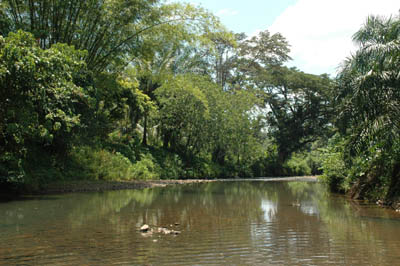
Remarks:
N. elegantissimus belongs into the N. longipectoralis group with N. longipectoralis Popta, 1904, N. masyae Smith, 1933, N. pallidus Kottelat, 1990, and share synapomorphies as follows: small size, forked to deeply forked caudal fin; coloration: series of blotches along lateral line, series of saddle blotches along dorsal line, black blotch in anteriormost rays of dorsal fin at about 1/4 of its height, prominent black spot at caudal peduncle, dark blotches at snout tip, head dorsally between eyes, postorbitally on operculum.
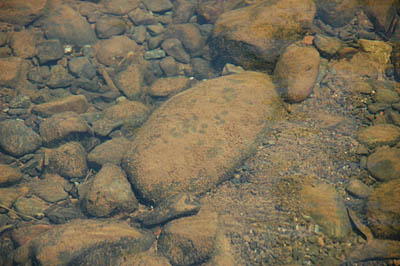
Some authors regard N.masyae as a junior synonyme of N. longipectoralis, for further reading see Kottelat (1990).
